Pros and cons of using tiles in the hallway
Decorative tiles are today recognized as the best material for finishing the floor in the hallway of a city apartment. The paved floor has its own characteristics:



What kind of tile to choose for the hallway floor?
The aesthetic task of the floor in the hallway is to be a harmonious background for the interior, not to spoil it. The choice of material largely depends on the area of the room. Tiles are:
- Square
- Rectangular
- Hexagonal
- Figured
- Metlakh
Large square tiles in a small hallway will only emphasize its small size. A long narrow hallway will be expanded by a striped floor made of tiles laid perpendicularly. In a spacious hallway, you can fully express your creativity. Both figured tiles and multifaceted Metlakh tiles in the form of a mosaic will look luxurious.


Types of floor tiles for the hallway
Today, environmentally friendly modern materials are used for its production. Three types are most common on the construction market:
- Ceramic. A large part of its composition is fired clay. Such a product perfectly retains its color, but the tile is quite fragile, so it is better to find another covering for the hallway.
- Porcelain stoneware. It is based on clay with the addition of granite chips. It is distinguished by its special strength and water resistance. The design allows you to imitate natural materials with high accuracy.
- Quartz vinyl. For its production, quartz sand is used, due to which the finishing properties are close to artificial stone, and polyvinyl chloride, which acts as a binding adhesive composition. Its main advantages are extraordinary wear resistance and durability.

The photo shows a hallway with a glossy ceramic coating. Brown inserts harmonize with decorative elements and furniture of the same shade.


Options for laying tiles on the floor
There are four main layout options.
- The simplest is the classic option, when the tiles on the floor in the hallway are laid parallel to the walls, in even rows. This type of flooring looks solid, laconic and at the same time saves time and materials.
- The second method of laying is diagonal. This method masks the unevenness of the floor well, looks attractive and visually expands the space of the hallway. Unfortunately, diagonal laying is very painstaking work and consumes a lot of materials when cutting.
- The third option for laying is “staggered” or “offset”, here rectangular products are used for the floor in the hallway. This type of tiling resembles brickwork and is used to imitate natural materials.

The photo shows a hallway with a classic tiling option.


The fourth method of laying tiles is “herringbone”. This method is used to imitate parquet and is suitable for narrow rectangular tiles. With the simplicity and originality of the layout, there is another undeniable advantage – minimum waste.

The photo shows two ways of laying tiles – “staggered” and “herringbone”. Visually, the covering is no different from parquet.
Color of tiles in the hallway
The choice of floor tiles in the hallway is of great importance for the perception of the interior as a whole. Its color range is so diverse that the design is limited only by the taste preferences and imagination of the apartment owner.
White
White gloss looks elegant and combines with any shades. Shining tiles reflect light and expand the space. But for the hallway, this is too slippery a surface, and dirt will be more noticeable on products with a rough surface and light grout.



On photo white tiles at the entrance, combined with walls and light wood.
Black
A hallway with a black floor should be spacious enough, otherwise it will narrow the space even more. Damage is more noticeable on such a floor. Therefore, black tiles are often combined with white tiles, laid in a checkerboard pattern.

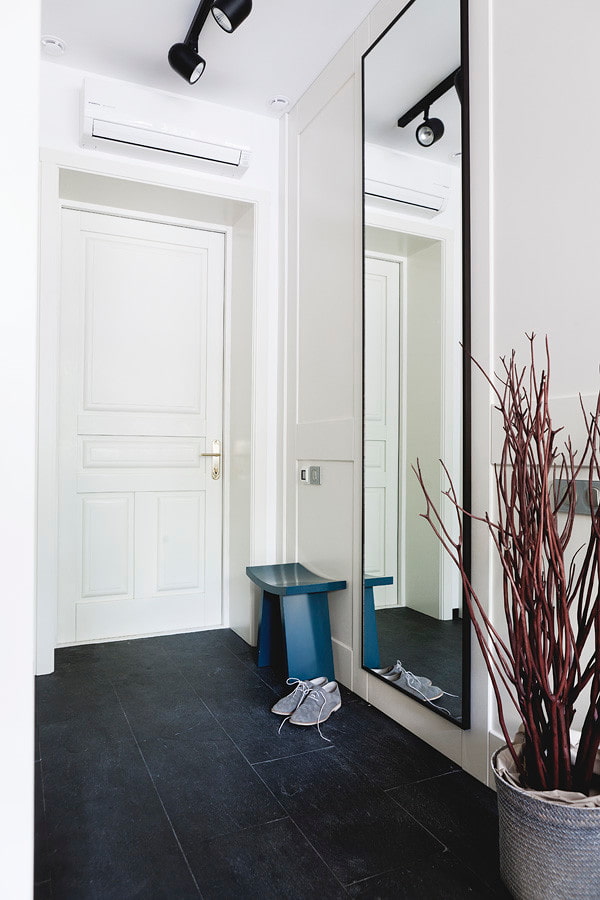
Gray
The most popular and advantageous option for the hallway, it harmonizes with any wall design. Scratches and dirt are less noticeable on it.


Beige
Beige is a neutral, warm color. Such a floor in the hallway will rather serve as a background for the decor than attract attention.

Blue
A specific choice, therefore it is more often found in two-color floor finishing.

In the photo, the contrasting blue edging favorably complements the pattern on the white background.
Red
This color in the hallway is often used in combination with white, or as part of patterns in muted tones: pink, burgundy.


Floor tile design
Today, the technology of manufacturing porcelain stoneware flooring allows you to apply any pattern to it. This helps to imitate wooden surfaces and achieve maximum similarity with laminate panels.
In the hallway, the “wood” and “laminate” covering looks stylish and expensive, and also combines all the advantages of tiled and wooden floors. The color range is truly wide: for finishing the hallway, you can find samples with imitation of aged wood or brushing, oak of different tones from light brown to dark wenge.
A special place in the range of ceramic products is occupied by tiles imitating marble, granite, or onyx: its natural texture looks like natural stone. In the hallway, this noble texture looks especially elegant.

The photo shows a matte “wood-like” coating, similar to a wax coating. Manufacturers also offer a glossy coating to imitate varnish.
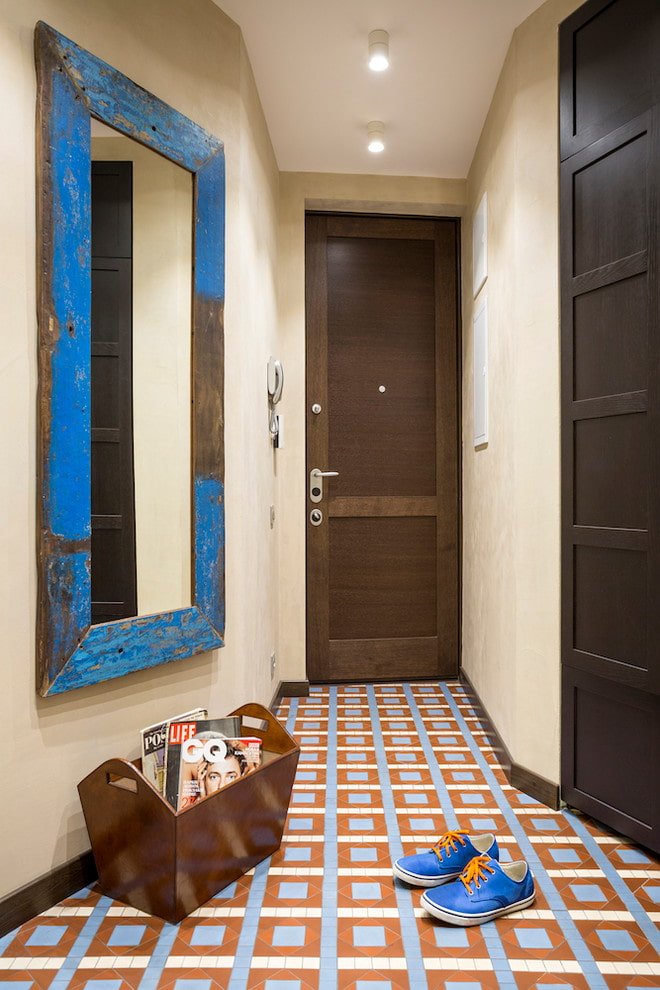

Patchwork style products are becoming increasingly popular: these are patterned tiles that resemble a patchwork quilt. A multi-colored floor in the hallway will fit perfectly into the Provence or Scandinavian style and will enliven the interior.

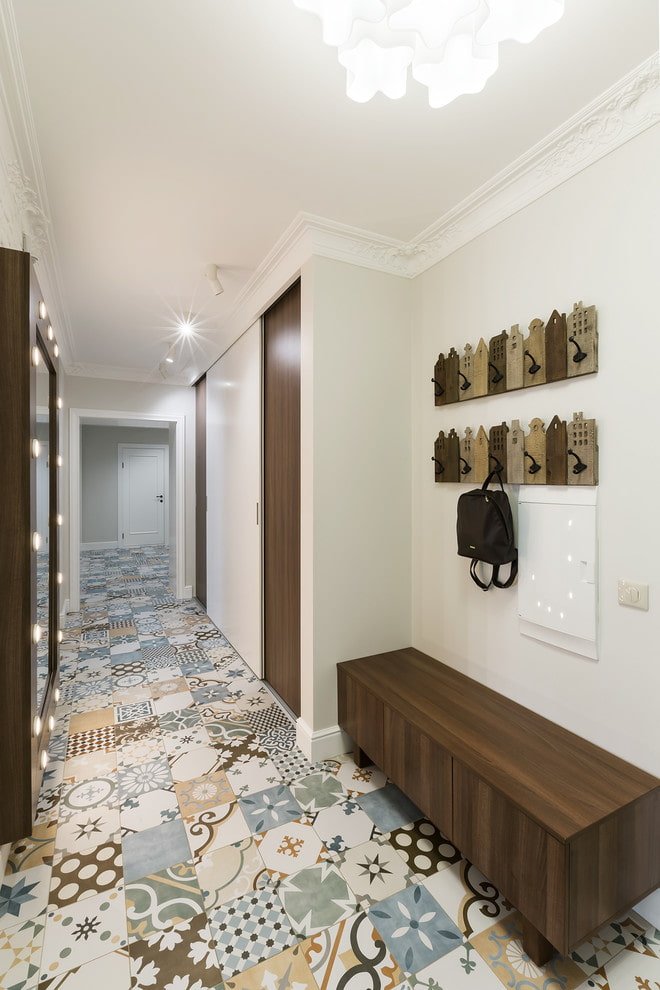


Hexagonal tiles resembling honeycombs are also successfully used in hallway decoration.

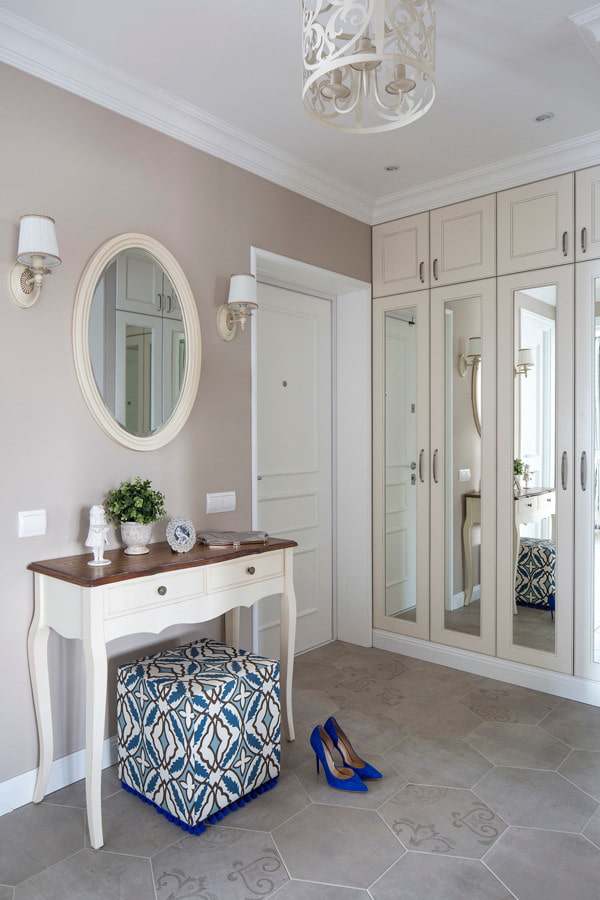
Photo of floor tiles with a pattern
Currently, designers create entire collections with various images on porcelain stoneware. The patterns applied by thermal printing amaze with their detail.
A popular trend today is products with an ornament. They are used to cover only part of the corridor area, creating a kind of carpet pattern.

The photo shows the original floor, where neutral tiles are laid around a bright pattern.


Clear geometric patterns add severity and a certain aristocracy to the hallway decor.

The photo shows a stylish combination of diamonds in different shades.
Examples of combined floors in the hallway
Such a floor in the hallway not only looks impressive, but also serves practical purposes: due to its strength, the tiles at the entrance protect the less wear-resistant coating from the impact of street dirt. In addition, the transition of materials from one to another zones the space of the corridor.
Tiles and parquet
A complex, but very interesting, is the combination of hexagonal “honeycombs” and natural wood. The flexibility of parquet allows joining two, at first glance, incompatible materials.


Tiles and linoleum
This type of joining is less expensive and troublesome. Linoleum can be cut in different ways, for example, in a wave or a semicircle. To unite the space and eliminate the difference in the floor in the hallway, a metal threshold is usually used.

The photo shows ceramic finishing at the threshold and linoleum laid in the rest of the hallway.
Tiles and laminate
This combination is the most reliable and durable. Facing in the hallway with tiles and laminate harmoniously fits into different interior styles.

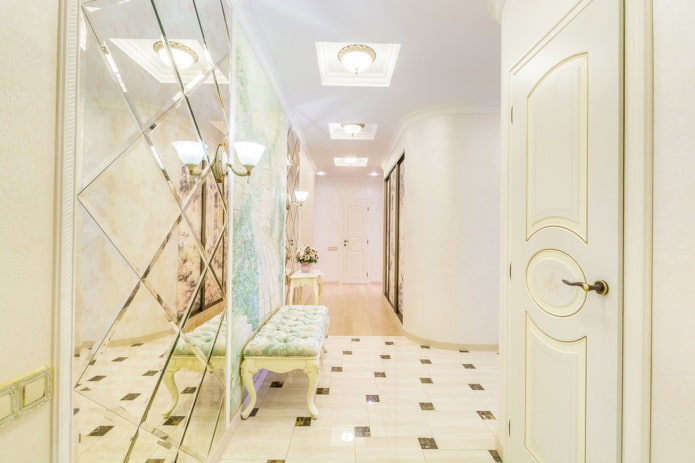
What tiles look like in different styles
Thanks to its diversity, ceramic coating is universal for all styles.
Loft lovers prefer imitation wood flooring (often aged) in the hallway. Minimalism is characterized by tiles with a laconic pattern – white, gray, with a concrete texture. Flooring products imitating natural stone emphasize the sophistication of the classics.

The photo shows a loft-style hallway with patterned tiles in black and white.


Patchwork finishing is currently the most popular in the Scandinavian style. Adherents of high-tech choose a modern pattern for the floor in the hallway, emphasizing the smooth lines of furniture and decor.


Now reading:
- Ultimate Guide to Buying a Pre-Owned Porsche
- Plasterboard partitions: 50+ photos and current ideas for zoning
- Ideas for landscaping a fence: what can be planted in a summer house? Photo gallery.
- Comprehensive Guide to Buying a Used Peugeot Boxer
- Sidewalk tiles: over 70 photos on paths, porches and steps.